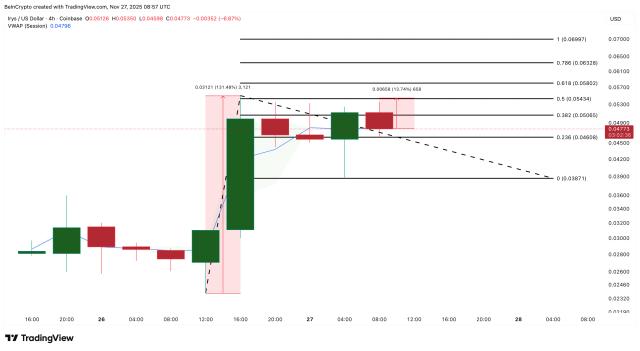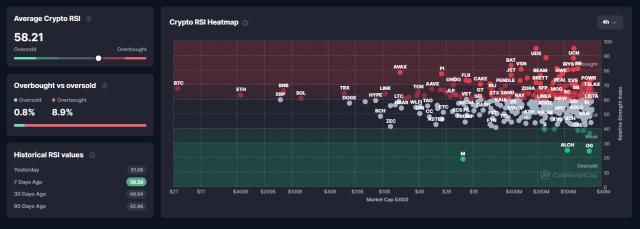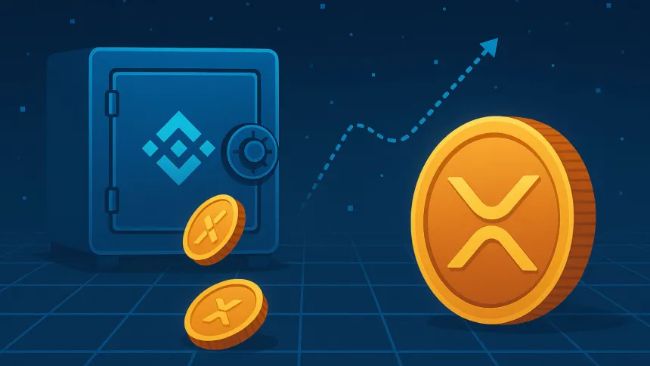Written by: @stacy_muur
Original title: The Perp DEX Wars of 2025: Hyperliquid, Aster, Lighter, and EdgeX
Compiled by: ODIG Invest
Amid the major upheaval in the crypto market, perpetual contract DEXs are facing a real clash.
Over the past few months, the four major platforms—Hyperliquid, Aster, Lighter, and EdgeX—have engaged in the fiercest competition in terms of growth, news, technological innovation, and institutional strength.
Behind the booming trading volume, is it an incentive-driven bubble, or a genuine need for long-term capital investment?
This report tracks the latest real-world transaction metrics, risk event performance, revenue data, and ecosystem expansion, attempting to answer a core question: Who are the true on-chain transaction giants who control the future?
This report will dissect the truth behind the data.
In 2025, the decentralized perpetual contract (Perp DEX) market experienced explosive growth. In October, Perp DEX's monthly trading volume exceeded $1.2 trillion for the first time, attracting widespread attention from retail traders, institutional investors, and venture capital.

For most of the past year, Hyperliquid was dominant, peaking at 71% of on-chain perpetual contract transaction volume in May. However, by November, its market share had plummeted to just 20% as new competitors continued to seize market share.
- Lighter: 27.7%
- Aster: 19.3%
- EdgeX: 14.6%
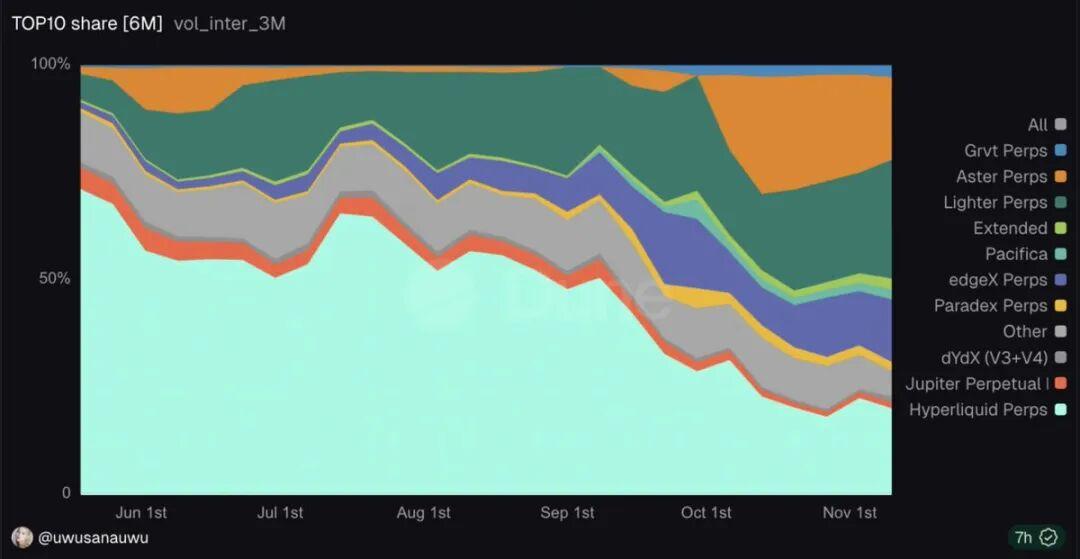
Thus, in this rapidly developing ecosystem, four major players have gradually emerged and are vying for enormous industry dominance:
- Hyperliquid — The veteran king of on-chain perpetual contracts
- Aster — A rapidly rising dark horse with massive trading volume and constant controversy.
- Lighter — A disruptor with zero transaction fees and native ZooKeeper.
- EdgeX — A more low-profile but potentially dark horse targeting institutions
This in-depth research will separate the wheat from the chaff, conducting a comprehensive analysis of each platform from aspects such as technology, data, controversies, and long-term sustainability.
Part 1: Hyperliquid – The Undisputed King
Why was Hyperliquid able to reach the top?
Hyperliquid has established itself as the industry-leading decentralized perpetual contract exchange, with a peak market share exceeding 71%. While competitors occasionally grab headlines with explosive growth in trading volume, Hyperliquid remains the structural core of the perp DEX ecosystem.
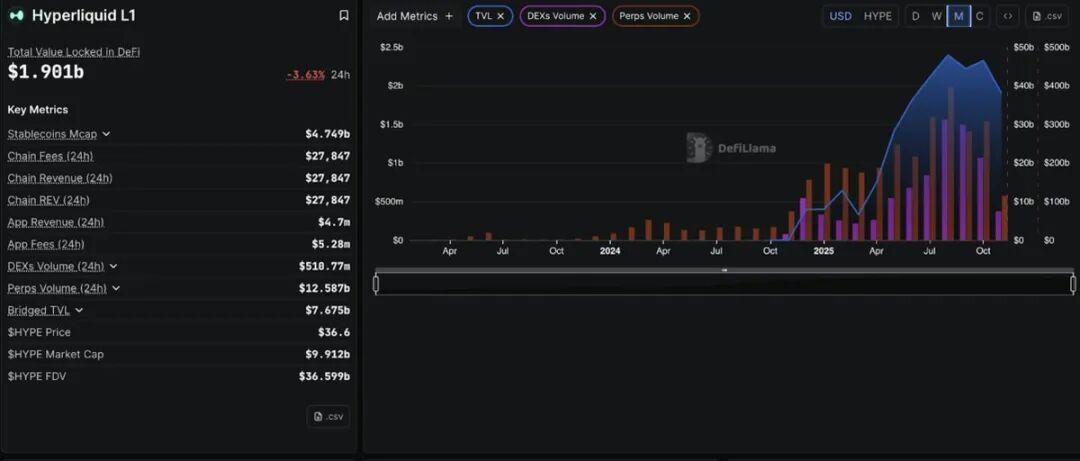
Technical basis:
Hyperliquid's dominance stems from a disruptive architectural choice: building a self-developed Layer 1 blockchain specifically for derivatives trading. Its HyperBFT consensus mechanism supports sub-second order finality and a performance of 200,000 transactions per second, comparable to or even surpassing centralized exchanges.
Open interest (OI) is the real indicator:
While competitors often display impressive 24-hour trading volume figures, the true indicator reflecting the real deployment of funds is the total open interest (OI) – the sum of the value of all perpetual contracts still in operation; trading volume represents activity; open interest (OI) represents the actual investment of funds.
According to 21Shares data, in September 2025: Aster accounted for about 70% of the total trading volume, while Hyperliquid once dropped to about 10%. However, this dominance only exists at the level of "trading volume", which is the easiest indicator to be artificially amplified through incentives, commission rebates, market maker rotation, or shakeout activities.
Based on the latest 24-hour open interest data:
- Hyperliquid: $8.014 billion
- Aster: $2.329 billion
- Lighter: $1.591 billion
- edgeX: $780.41 million
- Total open interest (OI) across the four major exchanges: $12.714 billion
Hyperliquid's share: approximately 63%. This means that Hyperliquid holds nearly two-thirds of the open interest on major perpetual contract trading platforms, exceeding the combined total of Aster, Lighter, and edgeX.
Open interest market share (24-hour data):
- Hyperliquid: 63.0%
- Aster: 18.3%
- Lighter: 12.5%
- edgeX: 6.1%
This indicator reflects where traders actually keep their funds in overnight positions, rather than where they are simply trading for incentives or frequent turnover.

Hyperliquid: A high OI/trading volume ratio (approximately 0.64) indicates that a large volume of trading activity translates into active, sustained positions.
Aster & Lighter: Low ratios (around 0.18 and 0.12) indicate frequent trading but relatively little capital remaining in the market, which is typically characterized by incentive-driven trading activity rather than persistent liquidity.
Full picture:
- Trading volume (24 hours) indicates short-term activity.
- Open interest (24 hours) indicates funds still at risk.
- OI/Trading Volume (24 hours) shows how much of the activity is driven by real funds and how much by incentives.
Based on all OI-based metrics, Hyperliquid is the structural market leader:
- Highest open interest
- Largest share of invested funds
- The OI/transaction volume ratio is the strongest.
- The total open interest exceeds the sum of the last three platforms.
Trading volume rankings may fluctuate, but open interest reveals the true market leader, and that leader is Hyperliquid.
Tested:
In the October 2025 liquidation event, a total of $19 billion in positions were liquidated, and Hyperliquid maintained perfect online time while handling the massive surge in transactions.
Institutional Recognition:
21Shares has submitted its Hyperliquid (HYPE) product application to the U.S. Securities and Exchange Commission (SEC) and has listed the regulated HYPE ETP on the Swiss exchange SIX. Media reports, including those from market tracking platforms such as CoinMarketCap, indicate increasing institutional access to HYPE. The HyperEVM ecosystem is also expanding, although publicly available data has not yet verified specific claims of "180+ projects" or "$4.1 billion TVL".
In summary, based on its existing filings, exchange listings, and ecosystem growth reported by tracking platforms such as CoinMarketCap, Hyperliquid demonstrates strong growth momentum and increasing institutional recognition, solidifying its position as a leading DeFi derivatives platform.
Part 2: Aster – Explosive Growth and Controversy
Aster is a multi-chain perpetual contract exchange that launched in early 2025 with a very clear goal: to provide users with high-speed, high-leverage derivatives trading on BNB Chain, Arbitrum, Ethereum, and Solana without requiring mandatory cross-chain bridging of assets.
The project was not built from scratch, but was born from the merger of Asterus and APX Finance at the end of 2024, combining APX’s mature perpetual engine with Asterus’s liquidity technology.
Explosive rise:
Aster launched on September 17, 2025, with a price of $0.08. In just one week, it surged to $2.42, an increase of 2,800%. At its peak, daily trading volume exceeded $70 billion, and it once dominated the entire perpetual contract DEX market.
Binance founder CZ supported Aster through YZi Labs and promoted it on Twitter, triggering a sharp rise in the token's price. In its first 30 days, Aster generated over $320 billion in trading volume and briefly held more than 50% of the perpetual contract DEX market share.

DefiLlama removed from shelves:
On October 5, 2025, DefiLlama, one of the most trusted data sources in the crypto space, removed Aster's data after discovering that the platform's trading volume was almost identical to Binance's—a perfect 1:1 correlation.
Real exchange trading volumes fluctuate naturally. Perfect correlation only means one thing: the data is artificially manipulated.
The evidence is as follows:
- The trading volume pattern is completely consistent with Binance (XRP, ETH, all trading pairs).
- Aster refused to provide transaction data to verify the authenticity of the transactions.
- 96% of ASTER tokens are concentrated in just 6 wallets.
- A volume/open interest ratio exceeding 58 (a healthy ratio should be below 3).
- ASTER's price immediately dropped 10%, from $2.42 to approximately $1.05.
Aster's defense:
CEO Leonard claimed that this correlation was merely hedging by "airdrop hunters" on Binance. But if that's the case, why refuse to provide data to prove it? Aster relaunched a few weeks later, and DefiLlama warned: "It's still a black box; we can't verify the data."
Actual function:
To be fair, Aster does have some real features: 1001x leverage, hidden orders, multi-chain support (BNB, Ethereum, Solana), and yield-generating collateral. It is building the Aster Chain based on zero-knowledge proofs to ensure privacy. But even the best technology cannot mask misleading data metrics.
in conclusion:
The evidence is as follows:
- Perfectly related to Binance
- Refusing transparency = concealing the facts
- 96% of tokens are concentrated in 6 wallets = centralized control
- DefiLlama being removed from app stores = damage to reputation
Aster extracted enormous value by leveraging CZ's popularity and artificially inflated trading volume, but failed to build genuine infrastructure. It may survive thanks to Binance's support, but its reputation is permanently damaged.
- For traders: Extremely high risk. You are betting on CZ's narrative, not actual growth. Set tight stop-loss orders.
- For investors: Avoid. There are too many risk signals; there are better options (such as Hyperliquid).
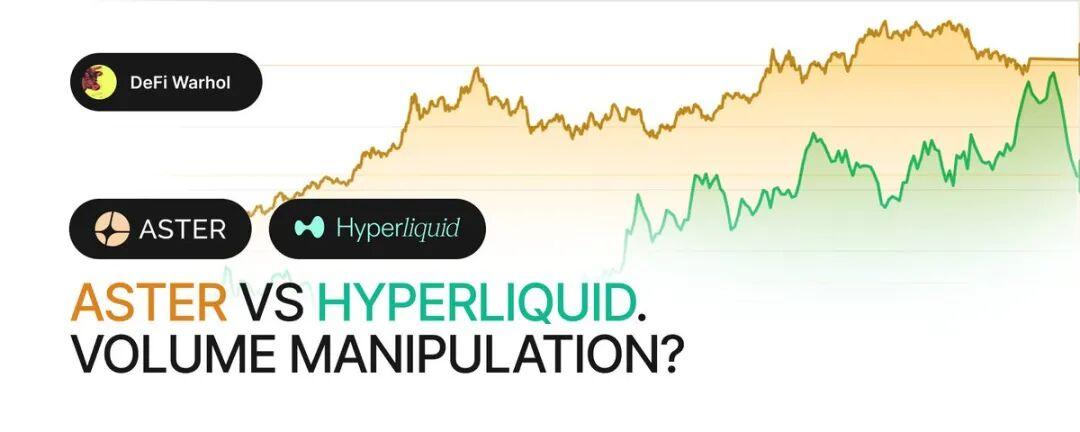
Part 3: Lighter — Technology has potential, data is questionable
Technical advantages:
Lighter is different. Founded by former Citadel engineers and backed by Peter Thiel, a16z, and Lightspeed (raising $68 million at a $1.5 billion valuation), it uses zero-knowledge proofs to cryptographically verify every transaction.
As an Ethereum Level 2 blockchain, Lighter inherits Ethereum's security through an "escape pod" mechanism—if the platform malfunctions, users can retrieve their funds via smart contracts. Application blockchains (Level 1) lack this security guarantee.
Lighter launched on October 2, 2025. Within weeks, its TVL reached $1.1 billion. Daily trading volume was $7-8 billion, and it had over 56,000 users.
Zero commission = aggressive strategy:
Lighter charges 0% commission for both market making and takers. It's completely free. This makes other competing platforms almost unattractive to commission-sensitive traders.
The strategy is simple: seize market share through an unsustainable economic model, build user loyalty, and then monetize it.

The test on October 11th:
Ten days after the mainnet launch, the largest liquidation event in crypto history occurred, with $1.9 billion being liquidated.
- Highlights: The system handled 5 hours of chaos. LLP provided liquidity as competitors retreated.
- Problem: The database crashed after 5 hours, and the platform was offline for 4 hours.
- Bad news: LLP suffered a loss, while Hyperliquid's HLP and EdgeX's eLP made a profit.
Founder Vlad Novakovski stated that they had originally planned to upgrade the database on Sunday, but Friday's volatility destroyed the old system first.
Trading volume issues:
These data clearly show the practice of accumulating points:
- 24-hour trading volume: $12.78 billion
- Open interest (OI): $1.591 billion
- Trading volume/OI ratio: 8.03
*A health level <3 or >5 indicates a suspicious condition, while 8.03 is an extreme case.
For reference:
- Hyperliquid: 1.57 (natural growth)
- EdgeX: 2.7 (Medium)
- Aster: 5.4 (Worth watching)
- Lighter: 8.03 (Points farming behavior)
For every $1 a trader invests, only $8 of trading volume is generated—quickly doubling their investment to accumulate points, rather than holding a real position.
30-day data verification: Trading volume of $294 billion vs. cumulative open interest of $47 billion = ratio of 6.25, still too high.
Lighter's points program is extremely aggressive. Points will be converted into LITER tokens during a token generation event (TGE, Q4 2025/Q1 2026). The over-the-counter (OTC) market will price the points at $5-$100 or more. Considering the potential airdrop value could be tens of thousands of dollars, the explosive trading volume is understandable.
Key question: What will happen after TGE? Will users stay, or will trading volume collapse?
summary:
Advantages:
- Elite Technology (Zero-Knowledge Verification Effective)
- Zero transaction fees = a true competitive advantage
- Inheriting Ethereum's security
- Top-notch team and investment support
risk:
- A transaction volume/OI ratio of 8.03 indicates a high likelihood of excessive points farming.
- LLP suffered losses during stress testing.
- The 4-hour downtime raises questions.
- User retention rates after the airdrop have not yet been verified.
Key differences from Aster: No allegations of wash trading, and it wasn't delisted from DefiLlama. The high percentage reflects aggressive but short-term incentives, not systemic fraud.
In summary, Lighter possesses world-class technology, but its metrics are worrying. Can it convert users who farm points into real users? Technically, it's possible, but historical experience suggests it's unlikely.
- For those who want to rack up points: TGE presents a good opportunity.
- For investors: It is recommended to wait 2-3 months after TGE to observe whether the trading volume can be sustained.
- Probability assessment: 40% will become the top three platforms, and 60% will remain points-based reward platforms with excellent technical support.
Part 4: EdgeX – Institutionalized Professional Platform
Amber Group's advantages:
EdgeX operates differently. Originating from the Amber Group incubator, which manages $5 billion in assets, it brings together professionals from Morgan Stanley, Barclays, Goldman Sachs, and Bybit. This isn't a crypto-native team learning finance; rather, it's traditional finance (TradFi) professionals bringing institutional experience to DeFi. Amber's market-making DNA is directly reflected in EdgeX: deep liquidity, tight spreads, and execution quality matching centralized exchanges. Launched in September 2024, the platform has a clear goal: to achieve CEX-level performance without sacrificing self-custody. Built on StarkEx (StarkWare's proven ZK engine), EdgeX can handle 200,000 orders per second with latency below 10 milliseconds, comparable to Binance.
Lower transaction fees than Hyperliquid:
EdgeX outperforms Hyperliquid in all transaction fees:
- EdgeX taker percentage: 0.038% vs Hyperliquid percentage: 0.045%
- EdgeX market maker: 0.012% vs Hyperliquid: 0.015%
For traders with a monthly trading volume of $10 million, this can save $7,000–$10,000 annually compared to Hyperliquid. Furthermore, for retail orders (<$6 million), EdgeX offers better liquidity—tighter spreads and less slippage.
Real income, health indicators:
Unlike Lighter's zero-fee model or Aster's questionable data, EdgeX generates real, sustainable revenue. Current metrics:
- TVL: $489.7 million
- 24-hour trading volume: $8.2 billion
- Open interest (OI): $780 million
- 30-day revenue: $41.72 million (147% increase from Q2)
- Annualized revenue: $509 million (second only to Hyperliquid)
- Trading volume/OI ratio: 10.51 (interesting, but requires further analysis)
At first glance, a ratio of 10.51 seems bad, but the context needs to be considered: EdgeX launched with an aggressive points program to drive liquidity. As the platform matured, the ratio has steadily improved.
More importantly, EdgeX maintained healthy revenue throughout the process—proving that the platform had genuine traders, not just users who farmed points.

October stress test:
EdgeX performed exceptionally well during the October 11 crash (when $19 billion was liquidated):
- Zero downtime (Lighter downtime was 4 hours)
- eLP vault remains profitable (Lighter's LLP is losing money).
- Liquidity providers offer an annualized return of 57% (the highest in the industry).
At critical moments, eLP (EdgeX Liquidity Pool) demonstrated exceptional risk management capabilities, profiting from extreme volatility while competitors struggled.
What makes EdgeX unique:
- Multi-chain flexibility: Supports Ethereum L1, Arbitrum, and BNB Chain.
- USDT and USDC are supported as collateral.
- Cross-chain deposits and withdrawals are supported (Hyperliquid is only available on Arbitrum).
Best mobile experience:
- Official iOS and Android apps (Hyperliquid does not have a mobile app)
- A clean user interface makes it easy to manage your positions at any time.
Asian Market Focus:
Strategically entering the Korean and Asian markets through localized support and events like Korea Blockchain Week. Capitalizing on underserved regions while Western competitors vie for the same user base.
Transparent Points Program:
- 60% used for trading volume
- 20% for recommendations
- 10% for TVL/Vault
- 10% used for liquidation/OI
The statement explicitly states, "We do not reward wash trading." This is also supported by the metrics—the trading volume/OI ratio is improving, rather than deteriorating as if it were simply a matter of racking up points.
challenge:
- Market share: Perpetual DEX open interest accounts for only 5.5%. To grow, aggressive incentives (with the risk of wash trading) or significant partnerships are needed.
- Lacking killer features: The EdgeX performs solidly across the board, but nothing particularly outstanding. It's a "business class" option—comprehensive and reliable, but not revolutionary.
- Unable to compete on fees: Lighter's zero fees diminish the appeal of EdgeX's "below Hyperliquid" advantage.
- TGE's launch is later: expected in the fourth quarter of 2025, later than its competitors. It missed the initial hype surrounding the first airdrop.
In summary, EdgeX is the choice of professionals—steady excellence over flashy hype.
Advantages:
- Institutional support (Amber Group liquidity)
- Real revenue (US$509 million annualized)
- Vault offers the best returns (57% annualized, still profitable during market crashes).
- Lower transaction fees than Hyperliquid
- The indicators are clear (no scandals involving manipulation or wash trading).
- Multi-chain flexibility + Best mobile experience
risk:
- Small market share (OI only 5.5%)
- The trading volume/OI ratio is 10.51 (although improving, it is still relatively high).
- Lack of a single killer feature
- Unable to compete with zero-fee platforms
Suitable for:
- Asian traders seeking localized support
- Institutional users who need Amber liquidity
- Conservative traders who focus on proven risk management
- Mobile-first traders
- Liquidity providers seeking stable returns
In summary, EdgeX is likely to capture 10-15% market share in the Asian market, among institutional and conservative traders. It will not threaten Hyperliquid's dominance, nor does it need to, as it is building a sustainable and profitable market segment.
It can be seen as the "Kraken of perpetual contract DEXs"—not the biggest or the most flashy, but stable, professional, and trusted by mature users who value execution quality over hype.
For those who farm points: Opportunities are moderate; the market is less crowded than that of competitors.
For investors: Small positions are used for diversification. Low risk, low return.
Comparative Analysis: The Battle of Perpetual Contract DEXs

Trading volume/OI analysis:
Industry standard: Health ratio ≤ 3
Hyperliquid: 1.57 indicates a strong organic trading pattern.
Aster: 4.74 is relatively high, reflecting a large amount of incentive-driven activity.
Lighter: 8.19 High ratio, suggesting points-driven trading.
EdgeX: The impact of the points program in version 10.51 is visible, but it is improving.
Market share: Open interest distribution:
Total Market: Approximately $13 billion in open interest
Hyperliquid: 62%, Market Leader
Aster: 18%, a strong second place
Lighter: 12%, market share is growing.
EdgeX: 6%, focusing on niche markets
Platform Overview:
- Hyperliquid, Mature Leader:
Holding a 62% market share, with stable indicators
Annualized revenue of $2.9 billion, active share buyback program
All community models, reliable performance.
Strengths: Market dominance, sustainable economic model
Rating: A+
- Aster - High growth, high risk:
Deeply integrated with the BNB ecosystem, gaining support from CZ.
Facing DefiLlama data issues in October 2025
Multi-chain strategy promotes adoption
Advantages: Ecosystem support, retail user coverage
Key concern: Data transparency needs to be monitored.
Rating: C+
- Lighter, a technology pioneer:
Zero-fee mode, advanced ZK verification
Backed by top investors (Thiel, a16z, Lightspeed)
Performance data is limited prior to TGE (Q1 2026).
Advantages: Technological innovation, Ethereum L2 security
Key considerations: Business model sustainability, post-airdrop retention rate
Rating: Not Completed (Awaiting TGE Performance)
- EdgeX, Institutional Focus:
Supported by Amber Group, professional-grade execution.
Annualized income of $509 million, vault performance stable.
Asian market strategy, mobile-first
Advantages: Institutional reputation, steady growth
Key concerns: Small market share, competitive positioning
Rating: B
Investment Reference:
Trading platform selection:
Hyperliquid: Deepest liquidity, proven reliability.
Lighter: Zero transaction fees, advantageous for high-frequency traders.
EdgeX: Lower transaction fees than Hyperliquid, excellent mobile experience.
Aster: Flexible multi-chain architecture, deeply integrated with the BNB ecosystem
Token investment timeline:
HYPE: Tradeable
ASTER: Stay tuned for further developments
LITER: TGE anticipates post-launch evaluation metrics in the first quarter of 2026.
EGX: TGE anticipates Q4 2025, assessing initial performance.
Main conclusions:
Market maturity: The perpetual contract DEX sector has become clearly differentiated, with Hyperliquid establishing its dominance through sustainability metrics and community consensus.
Growth strategies: Each platform targets different user groups – Hyperliquid (professional traders), Aster (retail/Asian markets), Lighter (technology-oriented), and EdgeX (institutional investors).
Key metrics to focus on: The volume/OI ratio and revenue generation provide a clearer picture of a platform's performance than volume alone.
Future Outlook: Lighter and EdgeX's post-TGE performance will determine their long-term competitive position. Aster's future depends on its ability to address transparency issues and maintain ecosystem support.




